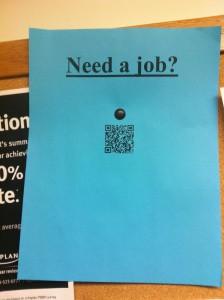
Lisa Wade over at our sister blog Sociological Images sent us an email from one of her readers, Steve Grimes, who shared this image and some interesting thoughts about how Quick Response codes or, QR codes can contribute to inequality. That is, QR codes such as these serve to make certain content and information “exclusive” to those who have smartphones. He states,
There is a general thinking that technology can create a level playing field (an example of this is can be seen with the popular feelings about the internet). However, technology also has a great ability to create and widen gaps of inequality.
In a practical sense the company may be looking for students who are tech savvy. They may also want to save on ink toner (might be a stretch). So using the matrix barcode may serve that purpose. However, the ad also shows how technology can exclude individuals; primarily in this case, students without smart phones. One may think that being on a college campus every student would have a smart phone. However, when you look at the prices of most smart phones along with the prices for the plans of a carrier (usually somewhere $75-150 per month) one can see that not every student may have one. Especially considering the other things that they may have to pay for that are a bit pressing to their environment (books, food, etc).
And just on a common sense level the ad says “Need a Job”. For students who need work they may not be the population of individuals who have the money to afford a smart phone to read the ad.

Grimes’ thoughts are judicious, and reveal the inherent structural difficulties in alleviating inequality. However, rather than revisit arguments on the digital divide, I believe it would be more effective to think about QR codes as one form of “digital exclusivity.” I am using the term to refer to the tendency of technology to re-entrench (mostly) class disparities in access to information. Those who cannot afford smartphones or who do not wish to pay for one are essentially excluded from being able to access this information. True, they may be able to access the information later when they have access to a computer, but that requires a much greater interest in the content than the person who casually scans the QR code. The person who has the smartphone is certainly living in a much more augmented world than the person without.
Eschewing the high popularity and price-tag of smartphones and the data plans they require, smartphone adoption does not guarantee the use of QR codes. Both of the authors of this article rarely use QR codes, despite the capacity to read them. Hamilton Chan, CEO and Founder of Paperlinks wrote an Op-Ed in Mashable where he lamented America’s dysfunctional relationship with QR codes:
Observing QR code adoption by mainstream America is sometimes like watching Charlie Brown set up to kick a football: The moment always seems so promising, but in the end, the effort comes up empty.
Globally, the adoption of QR codes do not seem to map on to cell phone adoption rates. When one compares the list of mobile phone penetration rates to QR code usage, there does not seem to be a lot of correlation. Japan, where QR codes are most popular (a Toyota subsidiary invented QR codes) actually has a cell phone adoption rate of only 84.1%. Compare that with countries that are not well-known for their use of mobile technology- Bulgaria (140.2%) Poland (123.48%), Chile (122.9%) and Brazil (111.6%). In Ghana, David Banks and Dr. Audrey Bennett found that while cell phone adoption rate is high (about the same as Japan) and many of those phones are smartphones capable of reading QR codes, not a single person recognized the black and white symbol.Grimes’ understandable frustration with feeling a digital divide, combined with the uneven usage of QR codes among mobile phone-using countries, leads us to believe that those black and white squares do more to instill a feeling of digital exclusivity than anything else.


Comments 2
Skweekah — September 7, 2011
It'll work. It's not about exclusivity. The web used to be exclusive, now anyone, regardless of skill, can use it. There is no longer exclusivity on the Web. If used properly and with the increase of capable devices, it will catch on. Phone prices will come down in price.
Eric — February 17, 2012
Qr codes allow people to stay connected online. 2012 will be the boom year for this technology as public awareness grows. Much like the boom to the internet didn't flourish overnight, qr code usage will grow as technology grows and people start seeing the value and usefulness. Scanning a qr code to pay for a product is now available and prouct reviews are awesome too. Qr codes can do more than just link the real world to the world wide web.
This article does point out some encouraging stats that users should look to for marketing purposes. If a company or organization wishes to do businesses with the affluent then they may have to adopt the use of qr codes. One of the advantages of the qr code is that people who are truly interested scan and thus creators of qr codes are seeing better than average conversion rates.
Excellent Article.